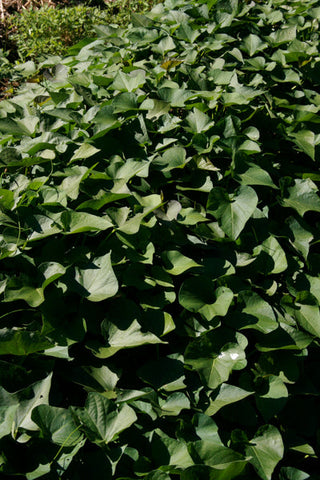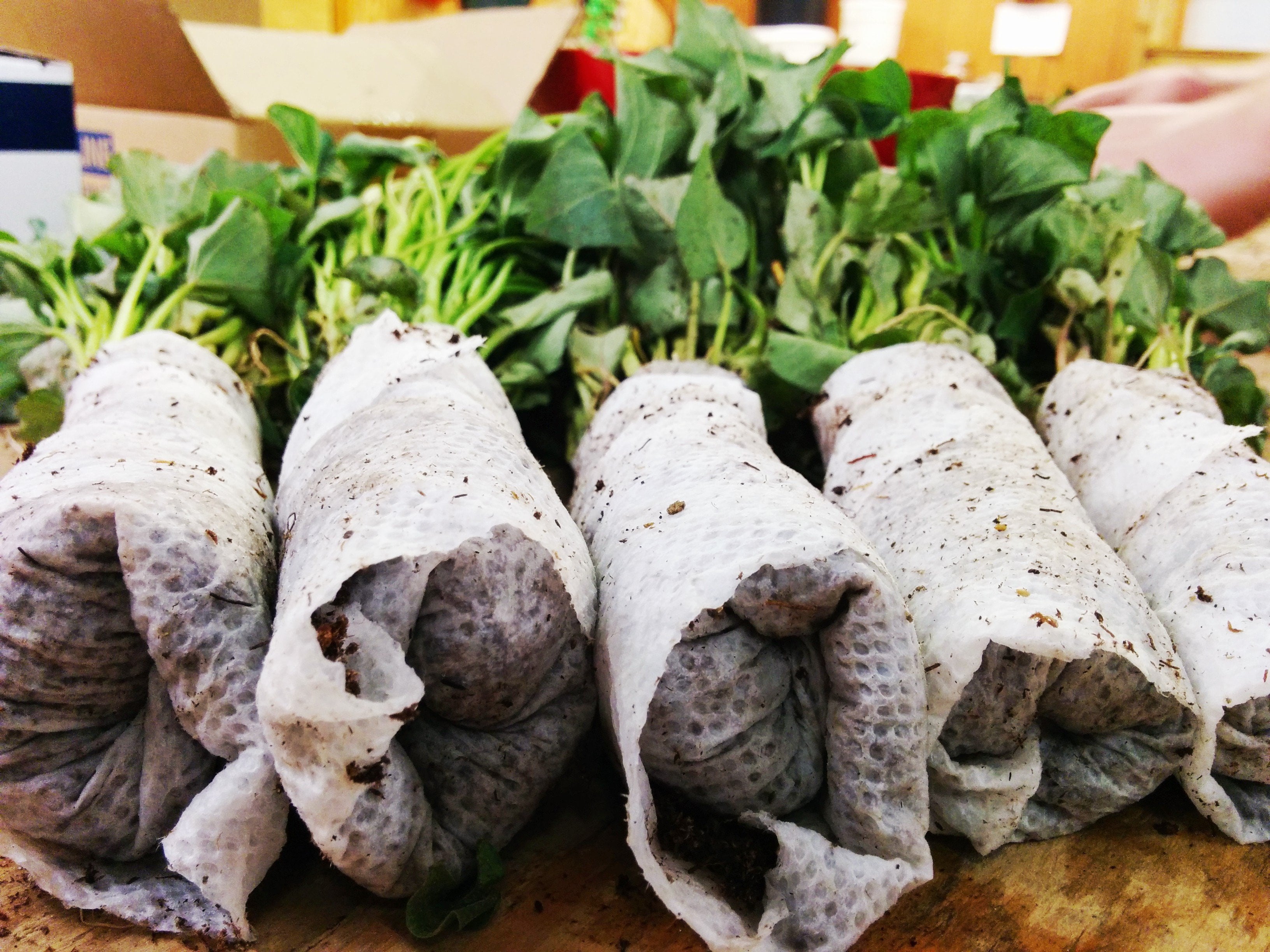As the soil warms up following the spring equinox and the days lengthen, we start to dream of our favorite summer crops. The first thing that comes to mind are the gorgeous green tendrils tumbling out of our raised beds, creating a small forest in our backyards. These enchanting vines belong to the gems we call sweet potatoes growing under the ground. I feel like these tubers bring the taste of summer to our winter tables, adding variety and color to what can seem like a stagnant diet. On top of that? The leaves are edible and provide wonderful greens throughout the summer months!
Did you know the sweet potato is North Carolina's official state vegetable? And for good reason! Sweet potatoes are well loved in the U.S., especially in the South. 40% of all sweet potatoes eaten in the U.S. come from North Carolina, grown mostly in the Piedmont area in the center of the state. The root crop has kept hunger at bay for many generations and was even a staple food during the Revolutionary and Civil Wars.

Sweet potato plants are actually a vine in the morning glory family. They were an important food to indigenous populations in the American tropics and the earliest known record of them was found in Peru and dates from 750 B.C. The Taino people, native to the Caribbean, called them batatas. This name morphed into patata, in Spanish, patae in French, and then “potato” in English.
Columbus supposedly brought the sweet potato to North America from the island of Saint Thomas. In 1542, DeSoto's Spanish explorers found them growing in what became Louisiana. They were also cultivated in the Carolinas before European colonization. All in all? Sweet potatoes have been an important crop for a long time and while they may have gone out of fashion, we say, let's bring them back!
What to Know Ahead of Time
Pre-ordering any of our live plants is a really good idea. We order plants, bulbs and tubers from growers far ahead of time, and the growers can only grow so much for a given season, so we often sell out of these items before the plants even arrive at our store. Ordering early helps ensure you get your pick of the varieties you want! We sell sweet potato slips (essentially sprouted sweet potatoes) in different sized bundles. Twelve slips is a good amount for a standard raised bed (3'x8').
From the moment the slips are plucked from the field, it is a race to get them into your garden. At Sow True, this means everyone drops what they're doing and heads to the warehouse to count slips and roll them into a damp and nutrient rich soil mixture. From here, we send them out as quickly as we can! You’ll want to open the box containing your sweet potato slips as soon as it arrives, and get those slips in the ground as soon as possible. Sweet potatoes are also surprisingly resilient. Chris Smith, of the Utopian Seed Project, once did a test on some slips that had lost all their leaves (the ones we don't sell). He planted some in a pot with damp soil and within a couple of weeks, they were sprouting new leaves and looking healthy and green! We like to joke that sweet potatoes are a dramatic bunch, feigning death when they're really full of life. Once you've planted them in your garden, it's almost guaranteed they'll droop and try to convince you they're dead or dying. Don't panic - keep them well watered and they'll perk up in a week or so!
If you order your sweet potatoes from us, the slips will be shipped out (or ready for pickup) during the first two weeks of June (or around that time). This is a great planting time for us in Zone 7! Check the planting calendar for your growing zone for your planting time.

Planting Sweet Potatoes
Slips are basically sweet potato sprouts that, once planted in the ground, will vine out and produce a cluster of sweet potatoes around the original slip.
While sweet potatoes tolerate most soils, the most important thing is to choose a spot in full sun. When the ground has warmed and all danger of frost has passed (this will typically be 3-4 weeks after the last frost date), plant your slips 3-4″ deep - up to the leaves and burying most of the stem. Sweet potato slips bruise easily and need gentle handling. Space them about 12-18″ apart with 3-4′ between rows. The vines will fill in, so give them plenty of room. Make sure the soil is loose and well drained. To give them a head start, you can plant them in raised rows, about 8″ high. The soil will warm faster in a raised row and the slope helps with drainage.
How to Care for Sweet Potato Plants
Once planted, give the slips a good soak. Water every day for about a week and then every few days until they get established. Sweet potatoes can be slow starters and they don’t like to compete with weeds. Keep the area clear until the top growth fills in and acts as natural mulch.
Occasionally you may lift the long vines to prevent advantageous rooting at their nodes. These nodes will attempt to produce tubers, though they take energy away from the original slips attempting to produce and will result in a lower yield.
Fertilizing sweet potatoes tends to produce more foliage than tubers so don’t bother. Once established, sweet potatoes are drought tolerant, but they will produce more if well watered. Read more about how to grow huge, county fair worthy sweet potatoes on our blog! Avoid watering your sweet potatoes during the final 3-4 weeks prior to harvest to keep the mature tubers from splitting.

Harvesting, Curing, and Storing Sweet Potatoes
Different sweet potato varieties have different days to maturity. Beauregard is 90-120 days, while White Bonita is 110-115 days. If you can remember when you planted them, you'll know when they should be ready. Sweet potato roots will continue to grow until a hard frost (29 degrees F) kills the vines. The crucial point to remember is to get them out before that hard frost.
Dig them carefully. Any damage to the skin invites rot. Push the shovel in about 10" away from the stem of the plant and lift. You'll probably find a variety of tuber sizes per plant. Let them lie in the sun to dry out and then gently brush off excess soil. Line containers with rags or other soft material to avoid scratching. Don't store injured roots - eat those ones first!
Once the tubers are dug, cure them for two weeks in a high humidity and high heat (though well ventilated) location for four to ten days. The recommended temperature for curing is 85-90 degrees F. An attic or barn would work nicely. Sweet potato flavor and storage quality improves by curing them first. This process converts the starches to sugars. Once the potatoes are cured, they should be stored in a cool, dry place like a basement with low humidity. This way they will last several months.

Sweet Potato Pests
Wireworms and root-knot nematodes are the biggest problems for sweet potatoes in home gardens. Avoid many diseases by choosing disease resistant varieties, using certified disease free seed sweet potatoes, and rotating their location from year to year. Mice and voles can also be a problem, so be on the lookout.
Now you're the sweet potato expert and we can't wait to see what you do with them!
| |
Article Written by: Angie Lavezzo |
|
About the Author: Angie Lavezzo is the former general manager of Sow True Seed. Beyond her professional role at Sow True, Angie's passion for gardening extends into personal hands-on experience, fostering plants and reaping bountiful harvests. |


